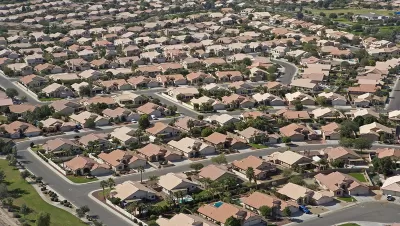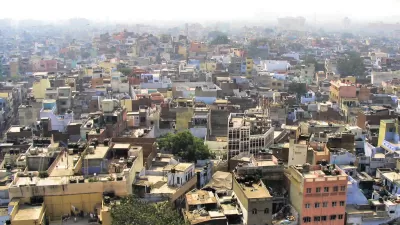A major new study estimates that sprawl costs the U.S. economy more than a trillion dollars annually, and results, in part, from planning and market distortions. Smart policy reforms can result in more efficient and equitable development.

A major new report, Analysis of Public Policies that Unintentionally Encourage and Subsidize Sprawl, written by the Victoria Transport Policy Institute for the New Climate Economy in partnership with the LSE (London School of Economics) Cities program, estimates the costs of sprawl, identifies planning and market distortions that foster sprawl, and describes smarter policies that can help correct these distortions.
The new report defines smart growth—the opposite of urban sprawl—as compact, connected and coordinated urban development. Smart growth cities and towns have well-defined boundaries, a range of housing options, a mix of residential and commercial buildings, and accessible sidewalks, bike lanes and public transportation. By reducing per capita land consumption and infrastructure and transportation costs, smart urban growth policies can deliver significant economic, social and environmental benefits.
The study's analysis starts by estimating the physical impacts of sprawl, including increased per capita land consumption, and greater distances between homes, businesses, services and jobs, which raises the cost of providing infrastructure and public services, and per capita motor vehicle travel and associated costs. It estimates that the most sprawled quintile American cities spend an average of $750 on infrastructure annually per capita, 50% more than in the least sprawled cities. This is consistent with findings previously published in another New Climate Economy report, Better Growth, Better Climate, which found that smarter urban growth policies could reduce global urban infrastructure capital requirements by more than US$3 trillion over the next 15 years.
Sprawl is bad for public safety and health. Americans who live in sprawled neighbourhoods are between two and five times more likely to be killed in car accidents and twice as likely to be overweight as those in more walkable neighbourhoods. The report also describes evidence suggesting that smart growth reduces per capita crime rates by increasing "eyes on the street" and improve opportunities for at-risk residents.
Residents of compact, connected communities in the United States save more money and have greater economic mobility than they would in more sprawled, automobile-dependent neighbourhoods. Households in accessible areas spend on average $5,000 less per year on transportation expenses, and real estate located in smart growth communities tends to retain its value better than in sprawled communities, due to greater accessibility to services. These communities are also more inclusive for people who cannot drive: they offer easier access to schools, public services and jobs, and encourage mixed-income communities. Because of these factors, research shows that lower-income children tend to be much more economically successful if they grow up in smart growth communities.
According to Nick Godfrey, Head of Policy and Urban Development at the New Climate Economy, "The New Climate Economy’s new report on urban sprawl proves that there is both an economic and an environmental case for smart cities. Smarter growth leads to cities that are greener, more productive and more prosperous. Developing countries in the early stages of urbanisation can reduce urban infrastructure and transportation costs by learning from the mistakes made by developed countries. Ninety percent of urban growth between now and 2050 is projected to take place in the developing world. By avoiding urban sprawl, developing countries can stimulate their economic growth while avoiding climate risks."
About the Global Commission on the Economy and Climate: The Global Commission on the Economy and Climate was established by seven countries: Colombia, Ethiopia, Indonesia, Norway, South Korea, Sweden and the United Kingdom, as an independent initiative to examine how countries can achieve economic growth while dealing with the risks posed by climate change. Chaired by former Mexican President Felipe Calderón, and co-chaired by renowned economist Lord Nicholas Stern, the Commission comprises 24 leaders from 19 countries, including former heads of government and finance ministers, leading business people, investors, city mayors and economists. It has been advised by a panel of world-leading economists chaired by Lord Nicholas Stern that includes two Nobel Laureates. Research for the Commission has been carried out by a partnership of leading global economic and policy institutes, including the World Resources Institute (Managing Partner), the Climate Policy Initiative, the Ethiopian Development Research Institute, the Global Green Growth Institute, Indian Council for Research on International Economic Relations, LSE Cities at the London School of Economics and Political Science, the Stockholm Environment Institute and Tsinghua University.
FULL STORY: Analysis of Public Policies that Unintentionally Encourage and Subsidize Sprawl

Alabama: Trump Terminates Settlements for Black Communities Harmed By Raw Sewage
Trump deemed the landmark civil rights agreement “illegal DEI and environmental justice policy.”

Study: Maui’s Plan to Convert Vacation Rentals to Long-Term Housing Could Cause Nearly $1 Billion Economic Loss
The plan would reduce visitor accommodation by 25% resulting in 1,900 jobs lost.

Planetizen Federal Action Tracker
A weekly monitor of how Trump’s orders and actions are impacting planners and planning in America.

Baltimore Ordered to Improve Sidewalk Accessibility
The city is one of many to face lawsuits for failing to comply with the Americans with Disabilities Act.

This Toronto Suburb Has More Bus Riders Than Columbus, Ohio
Brampton, Ontario used gradual improvements in service to prove that if you build it, they will ride.

Paris Bike Boom Leads to Steep Drop in Air Pollution
The French city’s air quality has improved dramatically in the past 20 years, coinciding with a growth in cycling.
Urban Design for Planners 1: Software Tools
This six-course series explores essential urban design concepts using open source software and equips planners with the tools they need to participate fully in the urban design process.
Planning for Universal Design
Learn the tools for implementing Universal Design in planning regulations.
Smith Gee Studio
Alamo Area Metropolitan Planning Organization
City of Santa Clarita
Institute for Housing and Urban Development Studies (IHS)
City of Grandview
Harvard GSD Executive Education
Toledo-Lucas County Plan Commissions
Salt Lake City
NYU Wagner Graduate School of Public Service



























